
Feature Articles
Food Safety Day 2011
cum "Live It, Use It"
Nutrition Labelling Promotion Award Scheme
Award Presentation Ceremony
The Nutrition Labelling Scheme is aimed at assisting the public in making informed food choices, and also encouraging the food trade to apply sound nutrition principles in the formulation of food. The Scheme has been operating smoothly since its implementation on 1 July 2010. Since behavioural changes and habit development require long term efforts, the Centre for Food Safety (CFS) of the Food and Environmental Hygiene Department has rolled out a two-year enhancement educational and publicity programme on nutrition labelling.

Officiating guests officiate at the opening ceremonies of the roving exhibition of posters (top) and the Food Safety Day 2011 (bottom) held at the Rayson Huang Theatre of The University of Hong Kong on 8 July 2011
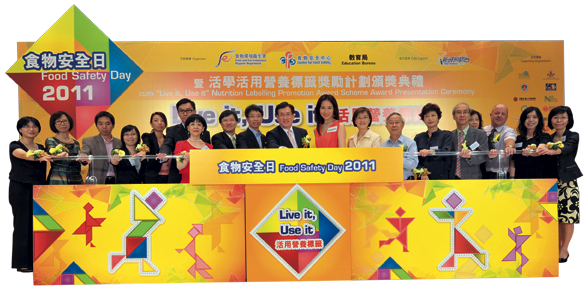
Participating teams brief the officiating guests on their promotional activities on nutrition labelling
Emphasis has been placed on youth participation in executing the publicity strategy of nutrition labelling. Nutrition labelling and relevant topics have been integrated into the school curriculum at different levels with the co-ordination of the Task Force on Nutrition Labelling Education and the active collaboration of the Curriculum Development Institute of the Education Bureau (EDB). During the last academic year, the CFS and the EDB jointly organised for the first time the "Live It, Use It" Nutrition Labelling Promotion Award Scheme. Under the award scheme, a total of 35 teams from 21 secondary schools took part in various creative activities to promote nutrition labelling.
To recognise the creativity and efforts of the participants, the CFS and the EDB jointly held the Food Safety Day 2011 cum "Live it, Use it" Nutrition Labelling Promotion Award Scheme Award Presentation Ceremony on 8 July 2011.
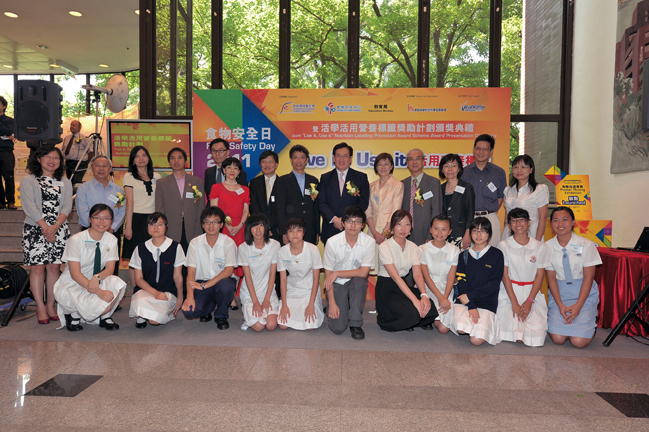
Group photo of the officiating guests and some of the participating teams taken at the venue
The ceremony was held at the Rayson Huang Theatre of The University of Hong Kong, where posters designed by the participating teams were exhibited. Some of the teams also gave presentations on their promotional activities on nutrition labelling and shared their experience in the morning sharing session.
Dr York Chow, Secretary for Food and Health, delivered an opening speech at the Award Presentation Ceremony in the afternoon and officiated at the opening ceremony. Other officiating guests included Mr Clement Leung, J.P., Director of Food and Environmental Hygiene; Dr Constance Chan, Controller of the Centre for Food Safety; Dr Cheung Kwok-wah, Principal Assistant Secretary for Education (Curriculum Development); Professor Kwan Hoi-shan, Chairman of the Expert Committee on Food Safety; Miss Vanessa Yeung, an artiste; and representatives of organisations in support of nutrition labelling education.
Good Hope School, Yuen Long Public Secondary School and Pooi To Middle School (Team Name: 有營至型) respectively won the Gold, Silver and Bronze Prizes in the Junior Group of the "Live it, Use it" Nutrition Labelling Promotion Award Scheme. Tung Wah Group of Hospitals Mrs. Fung Wong Fung Ting College, Elegantia College (Sponsored by Education Convergence) (Team Name: Elegantia College) and Hotung Secondary School (Team Name: 營型一族) respectively won the Gold, Silver and Bronze Prizes in the Senior Group. Sacred Heart Canossian College (Team Name: 心繫廚房), Kowloon Technical School and The Association of Directors and Former Directors of Pok Oi Hospital Limited Leung Sing Tak College (Team Name : 營養戰士) each won a Merit Prize in the Senior Group. Good Hope School also won the Best Poster Presentation Prize in the Junior Group while the winning team in the Senior Group was Hotung Secondary School (Team Name: 營型一族). The winner of the Most Active Participation School Prize was Ju Ching Chu Secondary School (Kwai Chung).
With reference to the theme "Make Better Choices, Use Nutrition Labels" which the CFS has adopted to promote nutrition labelling, all at the venue performed Wing Chun exercise together as the last segment of the activities, symbolising that knowing how to read nutrition labels was, like practising Wing Chun, extremely beneficial to personal health.

Director Mr LEUNG and the guests lead all at the venue in performing Wing Chun exercise together
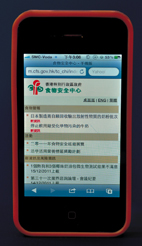
Readers' Corner
New Internet Initiatives
Centre for Food Safety Mobile Website (http://m.cfs.gov.hk)
With the increasing popularity of smartphones, more and more Hong Kong people are using smartphones for internet browsing. In view of this, the Centre for Food Safety (CFS) has launched a mobile website with a smartphone-friendly screen size to facilitate internet browsing with smartphones. The mobile website contains:
1. Latest Food Alert
2. Latest activities of the CFS
3. Latest information of the CFS
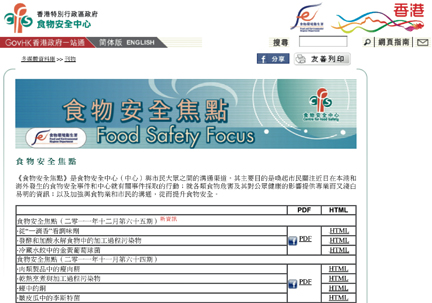
Food Safety Focus - Facebook  "Share" button
"Share" button
Food Safety Focus is an e-magazine published by the CFS on a monthly basis. Apart from reporting on food safety issues, both local and overseas, as well as the actions undertaken by the CFS in relation to these issues, it also provides easy-to-understand information on various food hazards and their public health risks, making it an important channel of communication between the CFS and the general public. A new Facebook "Share" button has been added on the webpage of Food Safety Focus to facilitate sharing of information through Facebook.
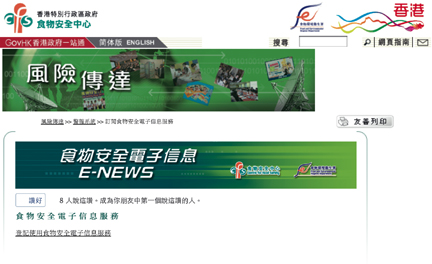
E-news –  "Like" button
"Like" button
A new "Like" button has been added on the webpage of E-news to facilitate sharing of information through Facebook.
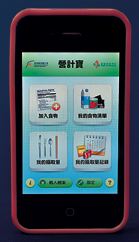

Nutrition Calculator (NuCal)
Nutrition Calculator (NuCal), an application tool developed by the CFS, lets you make better food choices by using nutrition labels anytime, anywhere. The main functions include:
1. Construct your personal food database
2. Calculate the nutrients you will take
3. Estimate your desirable nutrient intake according to the daily intake upper limit
Plant Hormones
| Question: | 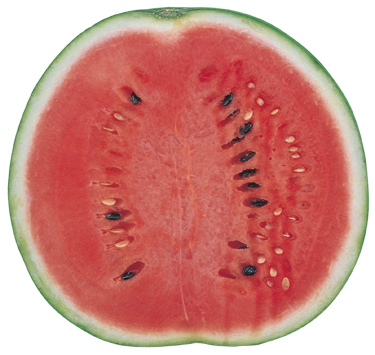
Some recent reports on "exploding watermelon" revealed that plant hormones are used in today's planting of fruits. Are these hormones hazardous to human health? |
| Answer: |
All plants naturally produce substances collectively known as plant hormones. Plant hormones are essential for regulating plant growth. In modern agriculture, people use natural or synthetic plant hormones to regulate growth of other plants, and these plant hormone substances are called plant growth regulators. The application of plant growth regulators in agriculture started in the 1930s in the USA. Among all plant growth regulators, ethylene is one of the best known examples. Ethylene can be produced naturally by ripening fruit or from synthetic sources. It is a gaseous plant hormone which can speed up the ripening process of many fruits, including bananas, apples, pears and melons. In folk wisdom, people put green (raw) bananas alongside a ripening apple to make them ripen faster. In fact, ethylene produced by the ripening apple is used to speed up the ripening process of the bananas. The "explosion of a watermelon" is believed to be caused by overuse of "forchlorfenuron", a plant growth regulator, during the planting process. Forchlorfenuron can induce cell division and cell differentiation and hence increase size and yield of fruits such as grapes, kiwifruits and watermelons. Proper use of forchlorfenuron will only pose a low food safety risk. From the regulatory control perspective, plant growth regulators are classified under "pesticides." An internationally accepted principle of regulatory control of pesticides is that all pesticides (including plant growth regulators) have to be registered with the competent authority before application in agriculture. Their safety and efficacy will be thoroughly assessed during the registration process. As long as growers follow good agricultural practice and properly use plant growth regulators, such as using them in the permitted type of commodities only, and following the recommended application rates, frequency and amount as well as the duration between the last application of the pesticide and harvest, residues of plant growth regulators in food can be kept to a minimum. |
A Brief of the Thirty-fourth Session of the Codex Alimentarius Commission
The thirty-fourth session of the Codex Alimentarius Commission (Codex) was held from 4 to 9 July 2011 in Geneva, Switzerland. The session was attended by 625 delegates from 145 member countries, including the Chinese delegation comprising 22 Mainland representatives and 2 Hong Kong representatives, 1 member organisation and 34 international governmental organisations (including the United Nations agencies) and non-governmental organisations. Codex, established jointly by the Food and Agriculture Organisation and the World Health Organisation of the United Nations, is an intergovernmental body that coordinates and establishes food safety standards at the international level. Food safety standards set by Codex are supported by comprehensive scientific studies, and represent the international consensus relating to food safety standards. As such, adoption of standards set by Codex can both protect public health and facilitate food trading.
In this session, scores of new or revised Codex standards or related texts were adopted and a series of proposals on work related to food safety and standards were approved. For food safety standards, they included the adoption and revocation of the maximum levels of more than ten food additives in various foods, about 400 maximum residue levels (MRLs) of scores of pesticides and 12 MRLs of 2 veterinary drugs, etc. With regard to the guidelines and Code of Practice (CoP) concerning food safety, the Commission adopted the CoP for the Prevention and Reduction of Ethyl Carbamate Contamination in Stone Fruit Distillates, the Guidelines for the Control of Campylobacter and Salmonella spp. in Chicken Meat, and the Revision of the Recommended International Code of Hygiene Practice for Collecting, Processing and Marketing of Natural Mineral Waters.
The full report of this session is available on the Codex website:
ftp://ftp.fao.org/codex/Reports_2011/REP11_CACe.pdf
News on New Dishes
Safety Tips on Preparing a Refreshing and Tasty Dish – Poached Whole Tomato Stuffed with Mixed Mushrooms
Dining out often means more meat, less vegetables and oilier food. But people are health-conscious nowadays. Those who choose diets that offer lower levels of fat, salt and sugar and contain less meat and more vegetables are on the increase. In this issue, we are honoured to have invited Chef Pun, Executive Chef of Dragon King Restaurant, to demonstrate how to prepare a healthy and tasty dish – Poached Whole Tomato Stuffed with Mixed Mushrooms. This dish, with tomatoes, Chinese spinach and mushrooms as the main ingredients and coated in a thick chicken soup, is really a happy and refreshing choice for the healthy eaters.
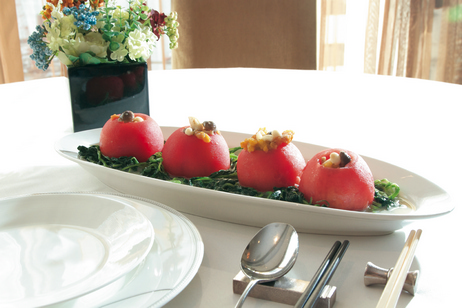
Poached Whole Tomato Stuffed with Mixed Mushrooms – ready to serve
| How to Prepare | Tips for Good Taste and Safety | |
|---|---|---|
| Rinsing | ||
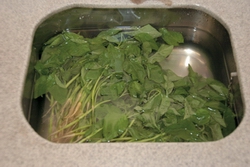 |
Rinse the vegetables and mushrooms. After rinsing, store them properly in a refrigerator at a temperature of 4oC. | Check the Chinese spinach before use and soak it in water for 1 hour to remove the rotten parts and possible pesticide residues. |
| Blanching | ||
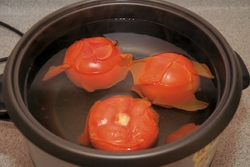 |
Blanch the tomatoes in hot water for a short while and then peel the tomatoes. | It is easy to peel the blanched tomatoes, and the peeled tomatoes are more delicious. |
| Steaming | ||
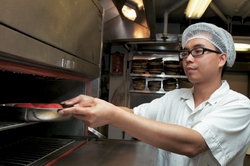 |
Remove the tomato seeds, fill the tomatoes with thick soup and steam them in a steam cabinet for 4 minutes. After steaming, take them out for use later. | Set the time and temperature properly before putting the tomatoes into the steam cabinet. |
| Stir-frying | ||
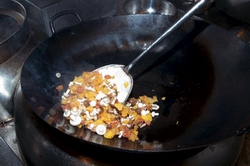 |
Bring the diced mushrooms (Shimeji mushrooms, yellow fungi and elm fungi etc) to a quick boil. Drain well and stir-fry them in a wok for about 3 minutes. Add a suitable amount of salt, chicken powder and oyster sauce. | An initial quick boil of the mushrooms makes them not only tastier but also softer, which can speed up the cooking procedures and ensure that they are thoroughly cooked. |
| Saucing | ||
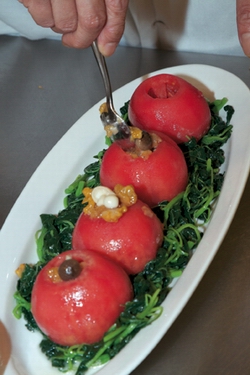 |
Place the blanched Chinese spinach flat on a dish and put the steamed tomatoes on top. Stuff the tomatoes with the fried mushrooms. Finally, pour the sauce made of thick chicken soup onto the tomatoes. | The thick chicken soup should be brought to the boil in a pan and kept boiling for at least 1 minute before pouring it onto the tomatoes. |
Tips from the Executive Chef:
- To make a good dish, it is essential to use fresh ingredients. As vegetables are perishable, the Restaurant will place orders with suppliers according to the estimated consumption of that day. Vegetables and mushrooms will be delivered to the Restaurant one to two days before cooking to ensure freshness, and upon delivery, they will be inspected thoroughly to eliminate any damaged or bruised vegetables as well as any dampened, spotted, stinky or slimy mushrooms.
- After inspection, vegetables will be washed under running water to remove any sand or grit from the surface, then stored at 4°C in a refrigerator. Vegetables will be stored on the "first-in-first-out" principle to ensure freshness, and they will be washed again before cooking.
- The Restaurant has established a supervisory system to ensure food and environment cleanliness. Staff are also provided with on-the-job hygiene training, various codes of hygiene and operational guidelines to make sure that they understand and comply with these codes and guidelines.
- The principle of separating raw and cooked foods, including storing raw and cooked foods in separate refrigerators and handling raw and cooked foods with different and clearly labelled cutting boards, knives and other utensils, has been strictly observed to avoid cross-contamination.
- To ensure that food is thoroughly cooked, directives for cooking time and temperature for all dishes have been provided.
- Refrigerator temperatures are checked and recorded by staff at fixed time intervals every day. Regular maintenance of refrigerators is also carried out to ensure that they are in good working order.
Food Safety Plan Corner
Poached Whole Tomato Stuffed with Mixed Mushrooms
Ingredients
Tomatoes, Chinese spinach, mixed mushrooms, Shimeji mushrooms, yellow fungi and elm fungi
Seasoning
Salt, oyster sauce, chicken powder and chicken soup
Step
- Rinse and peel the tomatoes. Remove the cores. Add chicken soup and steam for 4 minutes.
- Rinse and blanch the Chinese spinach until cooked. Dish up.
- Bring mixed mushrooms, Shimeji mushrooms, yellow fungi and elm fungi to a quick boil. Put them in wok and add salt, oyster sauce and chicken powder. Stir-fry until cooked.
- Place the tomatoes on the Chinese spinach. Stuff mixed mushrooms, Shimeji mushrooms, yellow fungi and elm fungi into the tomatoes. Pour heated chicken soup on top.
Production Process
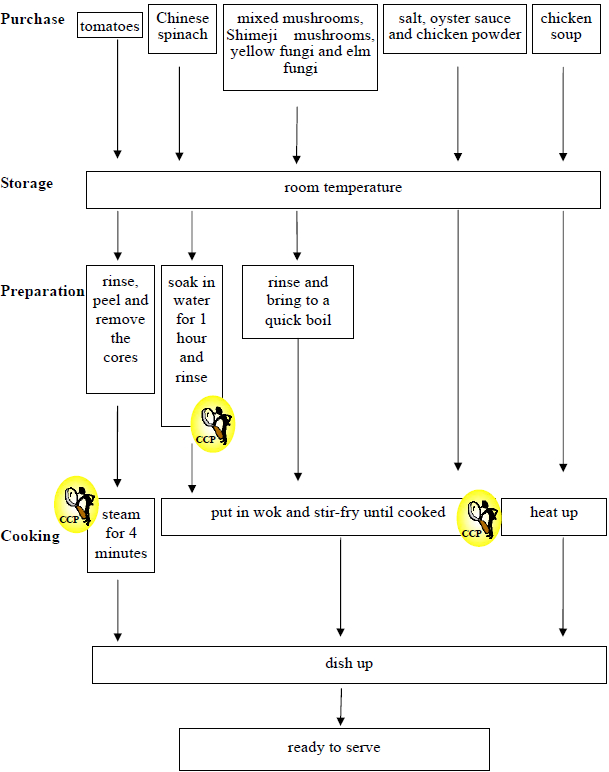
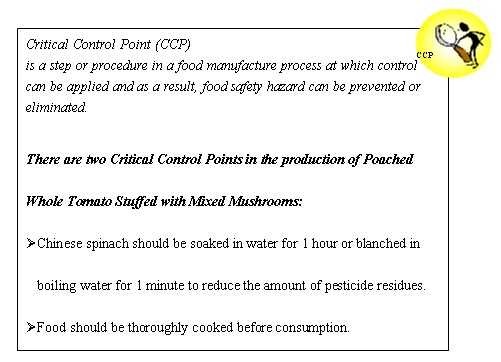
Briefing of Activities
(I) Public Talks of Centre for Food Safety
Since the Nutrition Labelling Scheme came into force on 1 July 2010, nutrition label "1+7" has been available on all applicable prepackaged foods and nutrition claims need to meet specified conditions. In order to facilitate consumers' understanding of nutrition labelling and promote its use in making informed food choices, the CFS organised, in collaboration with the Caritas Social Work Services Division, a public talk on 25 June. Seminar was held at the Food Expo at the Hong Kong Convention and Exhibition Centre on 12 August to introduce "Multi-perspectives on Nutrition Labelling".
To learn more about nutrition labels, you may visit the CFS website: www.nutritionlabel.gov.hk
(II) "Live it, Use it" Nutrition Labelling Promotion Award Scheme 2011/12
Enrolments are now invited for the "Live it, Use it" Nutrition Labelling Promotion Award Scheme 2011/12, which is jointly organised by the Centre for Food Safety (CFS) and the Education Bureau, and supported by the Committee on Home-School Co-operation. The Award Scheme aims at encouraging students to actively promote nutrition labelling for developing and consolidating healthy eating habits through the use of nutrition information. The Award Scheme can be incorporated into the Healthy School Policy, health-related co-curricular activities, and learning elements under life-wide learning or Other Learning Experiences. Participating students can fully utilise their potential in planning and implementing promotional activities.
Participants should enrol as a school team with guidance from their teachers. A school may form more than one team. Each team should consist of not more than ten core members and enrol into either Junior Group (F.1 to F.3) or Senior Group (F.4 or above).
Enrolment form can be downloaded from the CFS website. Completed forms can be submitted to the Risk Communication Section of the CFS. Enrolled teams will receive a resource package together with mentoring provided by the CFS and/or her professional partners. For further information, please visit www.nutritionlabel.gov.hk.
Food Safety Q&A
| Question: | What are pesticides? Why do we need to use pesticides? Will it be a problem if we consume food that has been sprayed with pesticides? What are the differences between pesticides and conventional contaminants? Is there any control over food contaminants in Hong Kong? |
| Answer: |
Pesticides are substances used to prevent, destroy, repel or mitigate weeds, unwanted insects, fungi, rodents and other pests. There are various types of pesticides, the commonly used ones include insecticides, herbicides, insect and plant growth regulators, etc. The use of pesticides has been recognised by the agricultural industry as a way to protect crops from infestation by pests or weeds, thus enhancing and stabilising the crop yield, keeping the nutritional integrity of food and facilitating storage to assure year-round food supplies. Notwithstanding the beneficial effects, the use of pesticides and its resulting residues require careful monitoring and regulation. Small amount of pesticide residues may remain in the crops or foods of animal origin even when pesticides are applied correctly according to the instructions. The potential adverse health effects of pesticides depend on the nature of the pesticides used, as well as the amount and duration of exposure. However, if the pesticide is properly used, the residual level in food will usually be very low and normal consumption of the food is unlikely to pose adverse health effects. For some pesticides that have been banned or are no longer in use (e.g. DDT, lindane), they may persist in the environment for a long time and enter the food chain at various levels of the ecosystem. Therefore, traces of their residues and metabolites may be present in food as environmental contaminants. As such, if a small amount of these pesticide residues is detected in food, it does not necessarily reflect that they are still being used in agriculture. To ensure that food on sale in the market is safe and fit for human consumption, the Centre for Food Safety (CFS) adopts a scientific approach in monitoring food contaminants, including pesticide residues, at import, wholesale and retail levels through the routine Food Surveillance Programme. |
Truth against Fallacy
Are "natural" food additives safer than synthetic ones?
No. It is a common misconception that natural food additives are safer than synthetic ones. The truth is that our body cannot tell one from the other. Take citric acid – an antioxidant used in food – as an example, whether it is extracted from lemons or formulated in a laboratory makes no difference to our body.
Some food naturally contains substances that can be used as additives. Carotene in carrots, for instance, can serve as a food colour additive. The level of food additives in food is subject to strict safety standards laid down by international food safety authorities. Under the internationally recognised safety standard, the level of carotene permitted in a food as an additive may even be lower than the level of carotene naturally present in a carrot.
Nowadays, we attach great importance to food safety. Consumers, relevant Government departments, food manufacturers and scientists are all concerned about the use of additives in food available in the market – the type of additives added, the reasons for adding them and if they are safe for consumption. In fact, the answers to all these questions can be found on the labels affixed on the food packages. The majority of prepackaged food items available in Hong Kong bear labels listing the ingredients (including food additives) in descending order of their proportions, enabling consumers to be better informed about the food.
Brain Gym
‘True (  ) or False (
) or False (  )' Questions
)' Questions
| 1. | Ham and other processed meat are "potentially hazardous" foods. |  |
| 2. | Ham sandwich should be stored in a refrigerator before consumption to avoid causing food poisoning. |  |
| 3. | If dry salami and Italian spicy sausages are used as sandwich filling, it is still safe even if not storing them in a refrigerator. |  |
| 4. |
Given the advanced development in milk product industry, it is now safe to consume unsterilised or natural milk products. |
 |
| 5. | It is a safe practice to keep cooked poached chicken at room temperature for a whole night. |  |
| 6. | When cooking chicken, the inner parts of the chicken thighs should reach a temperature of at least 75°C. |  |
| 7. | Leftovers should be stored in a refrigerator as soon as possible or within 2 hours. |  |
| 8. | You must wash your hands after handling raw meat or meat products to avoid cross-contamination of other foods by bacteria on your hands. |  |
| 9. | Cook minced meat or meat products thoroughly before consumption as cooking can eliminate causative bacteria. |  |
